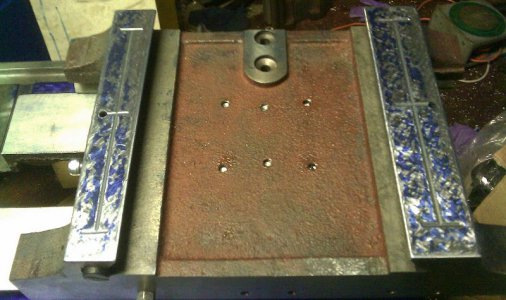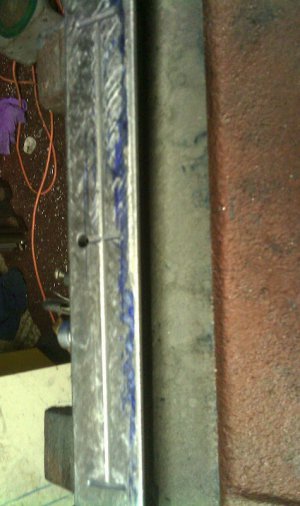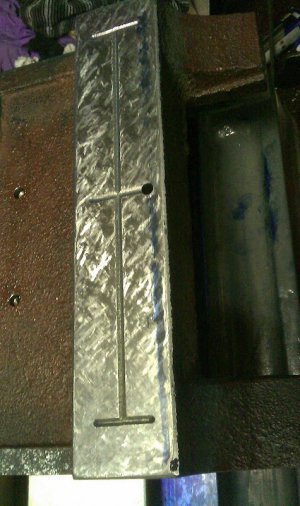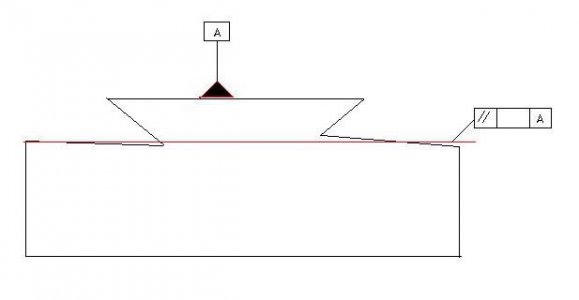Hi all,
First off, thanks for the previous post on the topic of reconditioning and machine way scraping.
Last February, I bought what a thought was a good deal. A band new Chester Super Lux Mill/Drill with DRO, Stand and assorted accessories. The grand idea was to convert it to CNC. Previously I had converted my little Chester lathe to CNC so I was pretty confident I could do it. I also own a well used round column mil/drill that is actually pretty handy. I installed a cheep DRO with capacitive scales similar to the ones found on you digital vernier.
The conversion of the new machine went pretty smoothly.
[video=youtube_share;fbEzZo76BDo]http://youtu.be/fbEzZo76BDo[/video]
So up until the beginning of the year the Chester Lux was working ok but for some reason the y axis was producing a lot of vibration even though I had plumbed in a single shot lubrication system. After faffing about with the electrics to ensure I was not losing motion somewhere, I took a closer look at the slide ways. What I thought was pretty hand scraping was ugly gouging. I guess the manufacturer did this improve lubrication....
Of course I would have been none the wiser had I not discovered scraping. First through Youtube then the various machining fora, that Richard, Forrest and McGyver post on.
So I decided to see what I could do about making this machine better by scraping it in.
The plan of attack is:
1) Scrape the y axis ways that are on the base using the clearance surface as a datum and the left side way. The left side way does not take the tapered gib and was pretty flat and parallel to the datum to begin with. Master for this is a camelback straight edge I picked up used and have scraped flat pretty well.
1a) scrape the right hand side flat and parallel to the datum and hence the right hand flat.
2) Scrape the dovetails in parallel once I am happy with the bearing. Will need a prismatic flat or a straight edge with a long wedge for dovetail spotting. for this. Anybody in the UK selling?
3) Scrape X-Y saddle flat and parallel using my granite table as a master
4) Fit the saddle to the base to scrape in the gib
The rest of the machine will have to wait until I am happy with the above.
Before I started the scraping, I got a 24"x18" granite surface plate, from Rotagrip. A Sandvik scraper from Greenwood with a 25mm wide blade. Diamond hand laps, diamond abrasive wheels came off ebay. For spotting I started with Stuarts Micrometer Blue and Red, the latter was not easy to find. I bought 3 different brayers from a craft shop, 2 hard, 1 soft. Then I came across a 2ft long camelback.
The surface plate arrive bone dry so I squirted it first baby oil, let is wet for a couple of day cleaned it off and repeated with WD40 to condition it nicely.
The scraper took me a while to figure out but I have found the various angles to use it at to get it to cut as wide, deep and more importantly the position I want to scrape. I use both hands on the shank and place the grip on my right shoulder. The hands guide, the shoulder pushes.
The spotting compounds were a waste of money. The red is too thin and barely visible when spread, can't even use it as a highlighting compound. The blue was OK but dried up too quickly and when thinned out was unworkable. Have settled for Dykem Hispot blue and will keep going with it since I can find any water soluble stuff here in the UK. Briefly tried water based poster paints but was not happy with how they spread.
Decided to attack the camelback first. The base was rectangular and not very proud of the superstructure. This was rectified on the manual machine. A relief was milled on the superstructure to get and a chamfer on the base. Both now allow spotting all the way into the dovetail relief. Following the good advice from the various masters on the internet I have achieved the following:
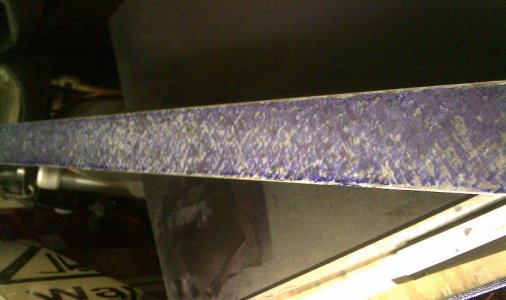
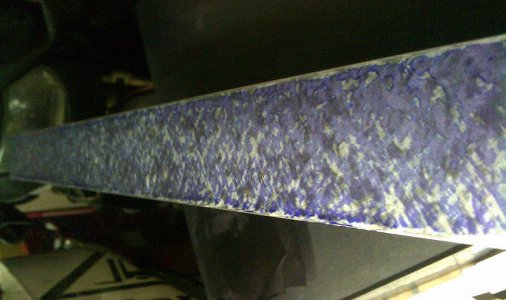
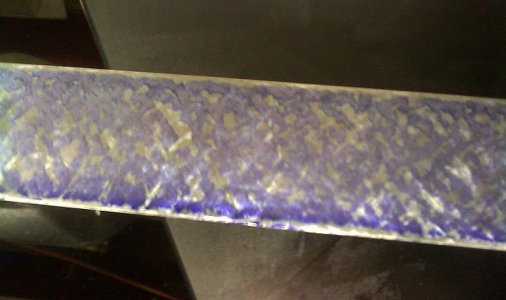
Click to see the larger picture Used a stone to deburr as the file I rounded left too many streaks. The edges are darker because the flat surface actually wrung onto the plate with the hispot. Had to knock it off as I could not lift it. Pretty happy with it actually. The remaining spotting on the surface plate looks like this:
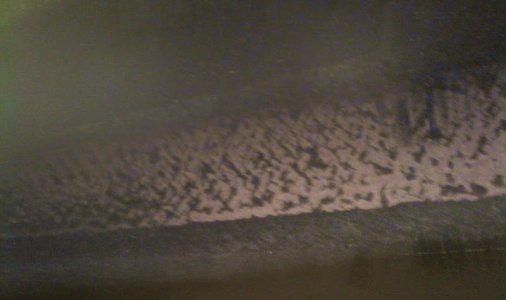
On a dry plate it rotates at around 2/3rds of the length away from the edge I am moving.
The base looks like this:
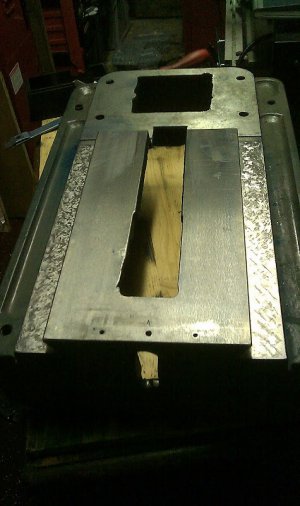
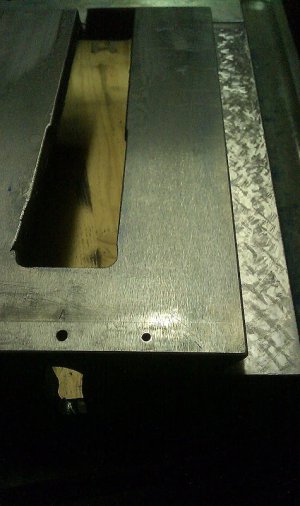
Notice that the flat clearance surface has an A stamped on. I guess this is to denote the datum the machine builder used too.
View of the original scrapejob...:
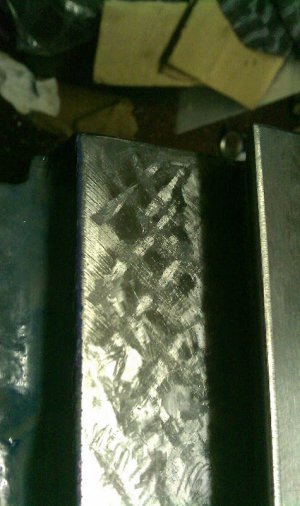
After a few cycles the flats looks like this:
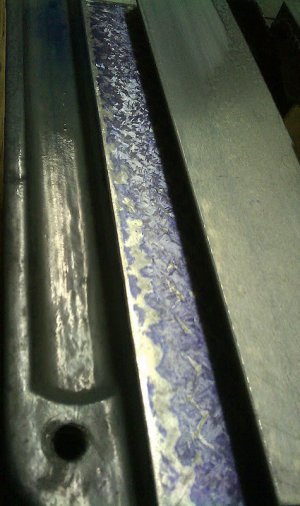
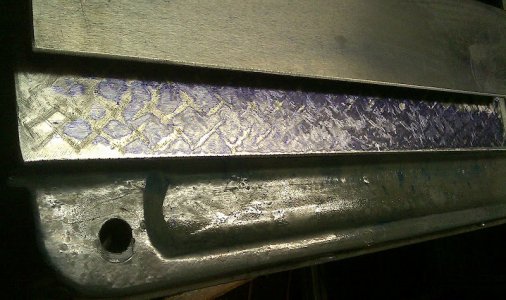
Notice the gouged oil retention features?
Photos of the tools to follow, didnt want to use the phone with my blued paws
Once I get the surface to a good flat condition I will measure it up and correct it if need be.
A tip to anybody thinking of buying a small Chester machine...don't. There are other similar sized machines with better construction out there see the youtube comments for more info.
Regards to all and again thanks!









First off, thanks for the previous post on the topic of reconditioning and machine way scraping.
Last February, I bought what a thought was a good deal. A band new Chester Super Lux Mill/Drill with DRO, Stand and assorted accessories. The grand idea was to convert it to CNC. Previously I had converted my little Chester lathe to CNC so I was pretty confident I could do it. I also own a well used round column mil/drill that is actually pretty handy. I installed a cheep DRO with capacitive scales similar to the ones found on you digital vernier.
The conversion of the new machine went pretty smoothly.
[video=youtube_share;fbEzZo76BDo]http://youtu.be/fbEzZo76BDo[/video]
So up until the beginning of the year the Chester Lux was working ok but for some reason the y axis was producing a lot of vibration even though I had plumbed in a single shot lubrication system. After faffing about with the electrics to ensure I was not losing motion somewhere, I took a closer look at the slide ways. What I thought was pretty hand scraping was ugly gouging. I guess the manufacturer did this improve lubrication....
Of course I would have been none the wiser had I not discovered scraping. First through Youtube then the various machining fora, that Richard, Forrest and McGyver post on.
So I decided to see what I could do about making this machine better by scraping it in.
The plan of attack is:
1) Scrape the y axis ways that are on the base using the clearance surface as a datum and the left side way. The left side way does not take the tapered gib and was pretty flat and parallel to the datum to begin with. Master for this is a camelback straight edge I picked up used and have scraped flat pretty well.
1a) scrape the right hand side flat and parallel to the datum and hence the right hand flat.
2) Scrape the dovetails in parallel once I am happy with the bearing. Will need a prismatic flat or a straight edge with a long wedge for dovetail spotting. for this. Anybody in the UK selling?
3) Scrape X-Y saddle flat and parallel using my granite table as a master
4) Fit the saddle to the base to scrape in the gib
The rest of the machine will have to wait until I am happy with the above.
Before I started the scraping, I got a 24"x18" granite surface plate, from Rotagrip. A Sandvik scraper from Greenwood with a 25mm wide blade. Diamond hand laps, diamond abrasive wheels came off ebay. For spotting I started with Stuarts Micrometer Blue and Red, the latter was not easy to find. I bought 3 different brayers from a craft shop, 2 hard, 1 soft. Then I came across a 2ft long camelback.
The surface plate arrive bone dry so I squirted it first baby oil, let is wet for a couple of day cleaned it off and repeated with WD40 to condition it nicely.
The scraper took me a while to figure out but I have found the various angles to use it at to get it to cut as wide, deep and more importantly the position I want to scrape. I use both hands on the shank and place the grip on my right shoulder. The hands guide, the shoulder pushes.
The spotting compounds were a waste of money. The red is too thin and barely visible when spread, can't even use it as a highlighting compound. The blue was OK but dried up too quickly and when thinned out was unworkable. Have settled for Dykem Hispot blue and will keep going with it since I can find any water soluble stuff here in the UK. Briefly tried water based poster paints but was not happy with how they spread.
Decided to attack the camelback first. The base was rectangular and not very proud of the superstructure. This was rectified on the manual machine. A relief was milled on the superstructure to get and a chamfer on the base. Both now allow spotting all the way into the dovetail relief. Following the good advice from the various masters on the internet I have achieved the following:



Click to see the larger picture Used a stone to deburr as the file I rounded left too many streaks. The edges are darker because the flat surface actually wrung onto the plate with the hispot. Had to knock it off as I could not lift it. Pretty happy with it actually. The remaining spotting on the surface plate looks like this:

On a dry plate it rotates at around 2/3rds of the length away from the edge I am moving.
The base looks like this:


Notice that the flat clearance surface has an A stamped on. I guess this is to denote the datum the machine builder used too.
View of the original scrapejob...:

After a few cycles the flats looks like this:


Notice the gouged oil retention features?
Photos of the tools to follow, didnt want to use the phone with my blued paws
Once I get the surface to a good flat condition I will measure it up and correct it if need be.
A tip to anybody thinking of buying a small Chester machine...don't. There are other similar sized machines with better construction out there see the youtube comments for more info.
Regards to all and again thanks!










